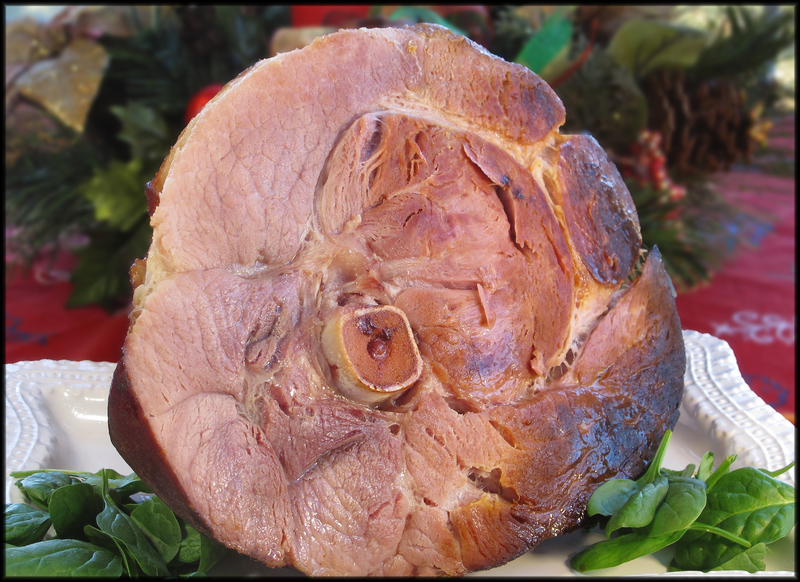Why is ham so popular as the main course for Christmas and New Year’s dinners? One reason might be that we’re tired of turkey - roasted on Thanksgiving and then appearing in an endless array of leftover configurations from simple sandwiches to quesadillas, casseroles and tetrazzini.
Another reason is tradition, stemming from the time when our ancestors were subsistence farmers growing their own food. By December, we would have been past the point of harvesting fresh peas, corn and tomatoes. Summer’s fruits would be canned and preserved. Our root cellars would be stocked with carrots, potatoes, squash and apples.
And, once the harvesting chores were over, we would turn our attention to the fattened pigs ready for slaughter. Most of the meat would be cured with salty brines or hung to age in a smokehouse. If there was anything left from the previous year, that piece of ham would end up as the roasted entree on the Christmas dinner table.
On New Year’s Day the featured dinner was often fresh, uncured ham from the newest batch of pigs. First, let’s clear up some potential confusion about nomenclature. A ham is actually the meaty, upper leg of the pig, whether or not it has been preserved. The lower leg portion is called the shank and the foot is, of course, the foot.
Over time, the word ham has come to refer to all kinds of processed pork products, even slices of pink meat without any bit of the pig’s leg included. Beyond that, there are some very specific types of ham, most notably the Virginia or Smithfield ham, named for the actual source of the processed meat.
These are salt-cured, smoked under hickory or red oak and then aged. You’ll find them in the grocery store, vacuum packed and hung in mesh bags near the meat case, but not refrigerated. Those not directly sourced from Virginia, but processed in this fashion are described as Virginia-style or country-style ham.
One of the surprising elements of this type of ham is that when you remove the packaging, you will often find a layer of mold covering the meat. This is not a sign that the meat is bad, but that the temperature and timing of the aging process went exactly according to plan.
Dry curing doesn’t involve any sort of injected brines typical of the refrigerated, grocery store hams and slices available year-round. For the Virginia ham, a mixture of salt, pepper and sugar is rubbed over the entire piece of meat, which is stored for a month or so at around 40 degrees. During this time, the salt penetrates the meat completely, acting as a preservative.
Once the cure is complete, the hams are smoked, wrapped and aged. Many of the exact timing and smoking combinations remain secret recipes used by prominent Virginia ham suppliers for many generations. During the aging step, it is not uncommon for a benign mold to form on the surface. Many purists believe this imparts an important flavor element to the ham.
Of course, the mold should be scrubbed off with a stiff-bristled brush before cooking. The ham should also be soaked for a couple of days in several water changes to draw out any excess salt. When you’re ready to heat the ham, the most popular approach is a gentle stove-top simmer in a combination of water and a liquid flavoring, such as ginger ale, apple cider, cola or vodka.
For those of you considering a fresh ham for a holiday dinner, you’re in for a treat. The meat’s texture is like a pork tenderloin, but richer and juicier because it’s cooked on the bone. Some butchers require advance notice to order one, so you may need to plan ahead for this menu. Roasting is straightforward and requires very little in the way of extra ingredients for a lovely main course.
The ham in the photo is not a Virginia ham, but a commercial brine-injected version we tried cooking a different way than we usually do. Instead of setting the ham in the pan on one of its fat-coated sides, we placed it face down in the pan so all of the fat and skin were exposed. As a result, the exterior was nicely crisped and the meat was tender and juicy.
Since we prefer not to glaze a baked ham with a syrupy mixture, I’ve included a recipe for an espresso-powder glaze that’s more aggressive than sweet. The actual baking recipe isn’t complicated, but the resting step is challenging: it’s difficult to resist cutting into the ham when the entire house is filled with its delicious aroma. Happy holidays!
Baked Ham
6- to 8-lb bone-in ham
1 T whole cloves
1 C dry white wine
Preheat oven to 325 F. Place ham in a roasting pan, cut side down. Cut fat into a diamond pattern, slicing through fat but not through meat. Insert cloves in each x of the grid. Pour wine over ham and cover tightly with aluminum foil. Bake, covered, for one hour. Remove foil and apply glaze, if desired. Continue baking until internal temperature reaches 135 F, about 15 minutes per pound. Remove from oven and allow to rest under a foil tent for 20 minutes before slicing.
Espresso Glaze
1 T espresso powder
2/3 C apple cider
1 t Worcestershire sauce
1 t Dijon mustard
1/2 t white pepper
Dissolve espresso powder in apple cider, whisking until smooth. Stir in remaining ingredients and apply to ham after one hour, basting every 20 minutes.
Roasted Fresh Ham
5- to 7-lb bone-in fresh ham, shank portion
salt
pepper
crushed chili flakes
2 C apple cider
Preheat oven to 350 F. Coat the inside of a roasting pan with nonstick cooking spray; set aside. Generously cover all sides of the meat with salt, pepper and chili flakes. Place the ham in the pan and add cider. Cover the pan tightly with foil and cook for 2 hours. Increase oven temperature to 425 F; remove foil and continue roasting, turning once, until internal temperature reaches 135. Allow to rest for 15 minutes before slicing.
Send comments, questions or recipe ideas to capeflavors@comcast.net.

















































